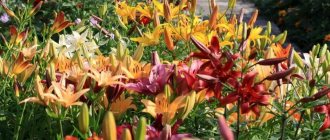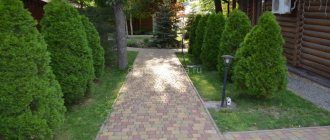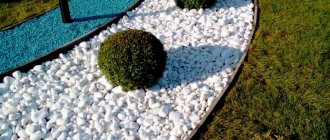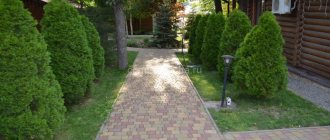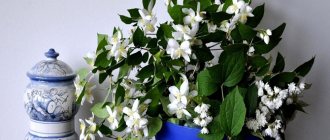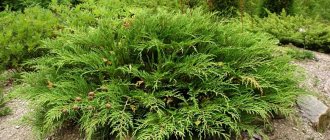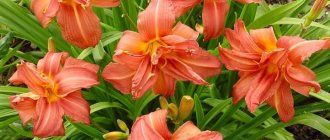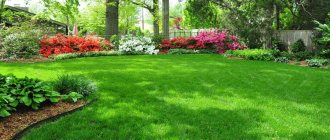It’s rare that a landscape designer’s idea is complete without round-shaped shrubs. Thuja Danica in this regard falls under the definition of the most preferred variety. Less than a meter in height and width, the evergreen Danica organically blends into the picture of an alpine hill, perfectly fills the spaces between medium-sized coniferous trees, and even looks interesting as a single planting.
Planting and caring for Thuja occidentalis Danica
What you need to know to grow pine crops in your garden - read on.
Landing location and lighting
One of the important factors for good shrub growth is the correct location. A well-lit, spacious area is the ideal place for Danika. It can also be planted in a semi-shaded place. Having planted a shrub in the dense shade of large trees, you can not hope for its beautiful appearance. In search of sunlight, the branches grow unevenly, the needles become dull, and the plant takes on an ugly, unkempt appearance. The area for planting shrubs should be protected from drafts and strong gusts of wind.
You might be interested
How to plant a Thuja hedge and care for it: what experts advise
What fertilizers for coniferous plants can be used in the garden
Why do coniferous trees turn yellow?
What soil is suitable for Tui Danica
The soil is preferably loose and well breathable. Space with close groundwater and wetlands are not suitable for growing shrubs. Excess moisture interferes with the normal development of the rhizome, leading to plant disease. The soil should be fertile, well-drained, slightly acidic.
Planting Thuja Danica seedlings in open ground
The plant is planted in the spring. For planting, dig a hole twice as large as the root system of the bush seedlings. The lower part of the space is filled with drainage (expanded clay, stone chips), then a mixture of soil and organic fertilizers is added. After planting, the seedling is watered abundantly, and the soil around the seedling is mulched.
When making a group planting, the distance between the holes should be at least 30 centimeters. In this case, the grown bushes will close their branches, creating a monolithic hedge. To create a beautiful spherical crown shape, the distance between specimens should be more than half a meter.
Watering
Thuja Danica, which is easy to care for, does not require watering in its adult state. Young plants at the stage of intensive growth and rooting need to be watered regularly and moderately. In dry summer, you can irrigate the crown with warm water to saturate the branches with moisture, giving them more strength and energy.
Thuja pruning
Sanitary pruning of shrubs is carried out in early spring. Remove damaged, dry shoots. The plant does not need crown formation. In the spring, thuja is fed with mixtures for coniferous plants. This allows you to increase the growth rate and has a beneficial effect on appearance.
Danika's wintering
Young seedlings need additional protection in winter; adult bushes with a well-developed root system do not need additional shelter. In severe frosts, the bush can be covered with snow, which will protect the crown from freezing.
Description of the variety
The encyclopedic name - Thuja occidentalis Danica - reflects the origin of the shrub. The literal translation from Latin is “western Danish thuja.” It was Danish breeders who developed this variety in the mid-twentieth century. By the way, the Danes did an excellent job, because Thuja Danika is now in the top dwarf coniferous trees.
This species reaches a height of 80 cm and grows up to a meter in width. The shrub reaches this size by 15 years, in some cases later. Like other Danish thujas, Danica is characterized by a high life expectancy: with proper care, according to gardeners, the plant reaches 150 years of age.
The Danika variety has very dense needles from soft shoots. The crown appears fluffy due to the vertical growth of the branches. Adult needles resemble scales and fit tightly to the stems, while young needles at the ends of the shoots are closer in shape to needles. During the warm half of the year, the coniferous covering is painted bright green. In autumn the needles turn brown, remain this way throughout the winter and turn green in the spring.
Danish thuja is very frost-resistant, which reflects the Scandinavian origin of the variety. The shrub tolerates frosts down to -29° without serious consequences. At the same time, the Danika variety is sun-loving. In the shade, the crown dims, individual branches begin to grow due to the need for solar heat, and the crown loses its shape.
Flowering is barely noticeable. The size of the cones is only 5-6 mm, they are round and brown in color. Cones appear very rarely and are practically unsuitable for reproduction.
Danish thuja is very frost-resistant, which reflects the Scandinavian origin of the variety.
How to propagate a coniferous tree
Thuja Danika can be propagated by seed and cuttings. The ripened seeds are left in the snow cover for the winter, collected in the spring, and planted in a container. Considering that thuja rarely bears fruit, the cutting method is more often used for propagation. Woody, healthy branches are used for cuttings. They are buried in the soil and watered regularly. For the first few years after planting, it is better to keep the seedling in a container. Only after the formation of a developed root system is the seedling transplanted into open ground.
History of creation
The bush is originally native to Canada and the United States of America. Being an indigenous species, the thuja was called the “tree of life.” During the colonization of America, it was exported to European countries, where it gained recognition as an ornamental plant. The thuja variety Danica was developed by Danish breeders in 1948, giving the name to the bush in honor of the country.
Thuya Danika
Varietal diversity
The popularity of the plant in landscape design prompted breeders to develop various varieties. Their main difference is the shade of pine needles.
For example, thuja Danica Aurea has a greenish-yellow crown color, while the Teddy variety has a dark green, rich color. Golden Golden Globe in spring has a golden-green tint of needles, by autumn it changes to orange, in winter - grayish with a golden tint.
Thuja globose Danica has a wide variety of varieties. The choice between varieties depends on individual preferences and design ideas.
Possible problems during cultivation
Thuja Globosa (Globosa) western spherical - description
Browned needles can sometimes be a manifestation of a fungal disease - rust. If after winter the needles do not return to their green color for a long time, it is worth spraying with the preparation skor and applying nitrogen fertilizing. It is necessary to regularly inspect the bark; pests, for example, false scale insects, can settle on it. If they are detected, treatment with the drug fufanon is carried out.
The characteristics of the thuja variety Danica allow this plant to rightfully take its rightful place in gardens and parks. It is easy to care for, so it will not cause any trouble for the gardener.
Reproduction at home
If you want to get the maximum number of thuja specimens, you need to independently engage in the plant propagation process, and the only effective way in this case will be cuttings.
The material is obtained from those shoots that are already partially or completely woody; it is best to plant them in the fall. The reproduction process consists of the following stages:
- Construction of a greenhouse. Rooting of cuttings is carried out at sufficiently high air humidity, while the walls should be as transparent as possible, because the plant needs lighting.
- When cutting off a shoot, the length of which will be approximately 50 centimeters, it is necessary to have a heel shoot. You should remove the needles from the lower part of the cutting and then soak it in a root stimulator.
- Preparing soil consisting of peat, sand and turf soil.
- Deepen the cutting by about 3 centimeters.
- Open the greenhouse daily for approximately 15 minutes and spray the cuttings.
Compatibility with other plants
Thujas look good even without participation in various plant compositions, by themselves. But this does not mean that they should not be used next to other plants. Any coniferous plants can be called excellent neighbors. Thuja will also look good next to barberry or bladderwort, elecampane, or purple coneflower.
It is almost impossible to remain indifferent to thuja. Just one plant planted on your plot will stun you with its appearance next year and motivate you to plant another thuja, and perhaps of a completely different variety. This shrub allows you to experiment in different ways without spoiling the appearance of the site. Thujas will be out of place in absolutely any period of time, and in general they look truly unimaginable.
Wintering
You should thoroughly prepare for winter frosts. First, you should check the health of your green pet: remove damaged branches, apply fertilizer, loosen the soil, sprinkle it in the root circle with mulch from sawdust or dry grass. It is best to secure the branches of a young plant around the trunk to make it easier to cover with fabric or prepared “paws” of pine and spruce trees. The area around the thujas is carefully treated from pests and rodents.
If the temperature drops below -30, the plant should be covered; thuja tolerates higher temperatures well. When there is a sudden cold snap, the bushes are simply covered with a large amount of snow.
Possible tree diseases and treatment methods
In terms of diseases, thuja Danika is as unpretentious as in terms of care. Pests are repelled by essential oils contained in the needles and bark of the tree. It is not for nothing that its raw materials are used for healing infusions. They disinfect, help fight thrush in gynecology, and are useful for elderly patients with joint diseases.
Often, thuja Danica is affected by diseases associated with lack of nutrition, excess sun or moisture. The latter leads to rotting of the tree. Direct sunlight dries out the needles. Against the background of the weakened state of the thuja, insects may join.
Usually these are spider mites and aphids. Both insects do not like humidity. Systematic spraying of plants helps. Additionally, you can use special compounds against aphids and mites, sold in gardening stores.
Thuja scale disease
Against the background of high humidity, thuja is susceptible to fungal diseases. Among them are brown mold and trunk rot. At the initial stage of damage, a drought regime helps. If the damage progresses, the diseased plant is uprooted and burned, and the ground near it is disinfected with fungicides.
They are also used as a preventive measure for putrefactive processes when cultivating the soil in the spring. It is in the soil that fungal spores lurk.
Thuja affected by Schutte disease
